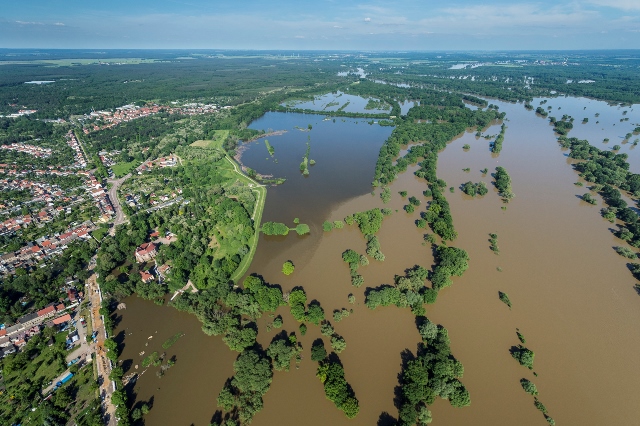Department of Conservation Biology
Working Group Floodplain Ecology
Riverine landscapes perfom important roles for the natural balance and are of central importance for humans. They provide a large set of services, such as the provision of drinking water or flood protection, they allow agriculture and let us recreate in stunning landscapes. The biological diversity of these ecosystems is often exceptional high, but due to the intense utilization riverine landscapes are among the most threatened ecosystems worldwide.
Using integrative approaches, our working group aims to link ecological processes in riverine landscapes and the societal demands on these systems. For this, we combine standardised fieldwork and modern data analysis. We also seek tight networking with social scientists within and outside the UFZ to create a timelyscientific basis for a sustainable use of riverine landscapes.

In our work, we especially investigate:
- ecological processes in riverine landscapes, especially the effects of multiple stressors on biodiversity
- the multifunctionality of riverine landscapes and assess exisiting trade-offs between ecosystem functions and services
- the effects of river and floodplain restoration measures (dyke relocations, river course revitalizations) on biodiversity and ecosystem functions
Group members
Guests
Ongoing projects
Selection of completed projects
Key publications
- CARRIZO, S.F., LENGYEL, S., KAPUSI, F., SZABOLCS, M., KASPERIDUS, H.D., SCHOLZ, M., MARKOVIC, D., FREYHOF, J., CID, N., CARDOSO, A.C. & W. DARWALL (2017): Critical catchments for freshwater biodiversity conservation in Europe: identification, prioritisation and gap analysis. J. Appl. Ecol. 54 (4), 1209 - 1218.
- WEISSER, W. W., ROSCHER, C., MEYER, S. T., EBELING, A., LUO, G., ALLAN, E., BEßLER, H., BARNARD, R. L., BUCHMANN, N., BUSCOT, F., ENGELS, C., FISCHER C., FISCHER, M., GESSLER, A., GLEIXNER, G., HALLE, S., HILDEBRANDT, A., HILLEBRAND, H., de KROON, H., LANGE, M., LEIMER, S., LE ROUX, X., MILCU, A., MOMMER, L., NIKLAUS, P.A., OELMANN, Y., PROULX, R., ROY, J., SCHERBER, C., SCHERER-LORENZEN, M., SCHEU, S., TSCHARNTKE, T., WACHENDORF, M., WAGG, C., WEIGELT, A.,WILCKE, W., WIRTH, C., SCHULZE, E.-D., B. SCHMID, & N. EISENHAUER (2017) Biodiversity effects on ecosystem functioning in a 15-year grassland experiment: Patterns, mechanisms, and open questions. Basic and Applied Ecology 23:1-73.
- VANNEUVILLE, W., WOLTERS, H., SCHOLZ, M., WERNER, B., UHEL, R., SNOJ, L., GLOBEVNIK, L., MYSIAK, J., SEIJGER, C. & C. SCHULZ-ZUNKEL (2016): Flood risks and environmental vulnerability : exploring the synergies between floodplain restoration, water policies and thematic policies. EEA Report 1/2016. Office for Official Publications of the European Communities, Luxembourg, 78 pp.
- RUMM, A., FOECKLER, F., DEICHNER, O., SCHOLZ, M. & M. GERISCH (2016): Dyke-slotting initiated rapid recovery of habitat specialists in floodplain mollusc assemblages of the Elbe River, Germany. Hydrobiologia 771 (1), 151 - 163.
- DEHNHARDT, A., SCHOLZ, M., MEHL, D., SCHRÖDER, U., FUCHS, E., EICHHORN, A., G. RAST (2015): Die Rolle von Auen und Fließgewässern für den Klimaschutz und die Klimaanpassung. In: HARTJE, V., WÜSTEMANN, H. & A., BONN, (Hrsg.): Naturkapital und Klimapolitik: Synergien und Konflikte.Technische Universität Berlin, Helmholtz-Zentrum für Umweltforschung – UFZ, Berlin, Leipzig: 172 - 181.
- SCHINDLER, S., SEBESVARI, Z., DAMM, C., EULLER, K., MAUERHOFER, V., SCHNEIDERGRUBER, A., BIRÓ, M., ESSL, F., KANKA, R., LAUWAARS, S.G., SCHULZ-ZUNKEL, C., VAN DER SLUIS, T., KROPIK, M., GASSO, V., KRUG, A., PUSCH, M.T., ZULKA, K.P., LAZOWSKI, W., HAINZ-RENETZEDER, C., HENLE, K. & T. WRBKA, (2014): Multifunctionality of floodplain landscapes: relating management options to ecosystem services. Landsc. Ecol. 29 (2): 229-244.
- SCHOLZ, M., MEHL, D., SCHULZ-ZUNKEL, C., KASPERIDUS, H.D., BORN, W. & K. HENLE (2012): Ökosystemfunktionen von Flussauen - Analyse und Bewertung von Hochwasserretention, Nährstoffrückhalt, Kohlenstoffvorrat, Treibhausgasemissionen und Habitatfunktion. Naturschutz und Biologische Vielfalt 124.
